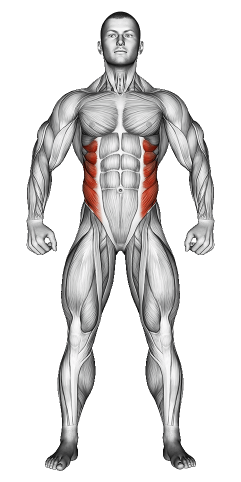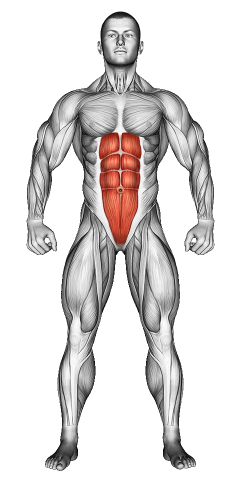Dumbbell Russian Twists: Video Tutorial & Exercise Guide

Written By: Claude Michael
Updated: Oct 13, 2024
| Workout | Dumbbell Russian Twists |
| Primary Muscle Group | Obliques |
| Secondary Muscle Group | Lower Back, Abs |
| Equipment Required | Dumbbell |
| Force Type | Rotational |
| Mechanics | Isolation |
| Exercise Type | Strength |
| Difficulty | Intermediate |
Dumbbell Russian Twists: Video Tutorial & Exercise Guide
- 1.Dumbbell Russian Twists: Muscle Groups
- -1.1Primary Muscle Group
- -1.2Secondary Muscle Group
- 2.Dumbbell Russian Twists: Step-by-Step Guide
- 3.Dumbbell Russian Twists: Overview
- 4.Dumbbell Russian Twists: Benefits
- 5.Dumbbell Russian Twists: Pro Tips & Advanced Techniques
- 6.Dumbbell Russian Twists: Progression Plan
- 7.Dumbbell Russian Twists: Frequently Asked Questions (FAQs)
Secondary Muscles Group
Dumbbell Russian Twists: Step-by-Step Guide
- Step 1: Sit on the floor with your knees bent and your feet flat on the ground. Hold a dumbbell with both hands at chest level, keeping your arms slightly bent.
- Step 2: Lean back slightly so that your torso is at a 45-degree angle to the floor. Engage your core to maintain balance and lift your feet off the ground, crossing your ankles for stability.
- Step 3: Begin the movement by twisting your torso to the right, bringing the dumbbell toward the floor beside your hip. Keep your arms slightly bent as you move.
- Step 4: Rotate your torso back to the center and then twist to the left, bringing the dumbbell toward the opposite side. Continue alternating sides, keeping control and using your core to rotate.
- Step 5: Repeat for the desired number of reps, maintaining a controlled and steady pace.
Dumbbell Russian Twists: Overview
The Dumbbell Russian Twist is a core exercise that primarily targets the obliques while also engaging the abdominals, lower back, and hip flexors. This twisting motion helps improve core strength and stability, making it an effective exercise for athletes and fitness enthusiasts alike.
By holding a dumbbell, you add resistance to the movement, increasing the intensity and making it a great option for those looking to build stronger, more defined obliques. The movement also helps enhance rotational strength, which is essential for sports and functional fitness activities.
Dumbbell Russian Twists: Benefits
Dumbbell Russian Twists primarily target the obliques, helping to strengthen and tone the side muscles of the core. This movement also engages the rectus abdominis (front abs), lower back, and hip flexors, making it a comprehensive core exercise.
The rotational motion in this exercise helps improve core stability and balance, which is essential for maintaining good posture and reducing the risk of injury. Additionally, the twisting action enhances functional strength, translating well to sports and everyday movements that require torso rotation.
Adding a dumbbell increases resistance, making it more challenging and effective for building muscle definition in the obliques and abdominals.
Dumbbell Russian Twists: Pro Tips & Advanced Techniques
Keep your core engaged throughout the movement and avoid rushing the twists. Focus on controlled, deliberate rotations to maximize core engagement. For an added challenge, try using a heavier dumbbell or slow down the movement to increase time under tension. Ready to build rotational strength and a stronger core? Let’s twist!
Dumbbell Russian Twists: Progression Plan
Beginner
Intermediate
Advanced
Dumbbell Russian Twists: Frequently Asked Questions (FAQs)
What muscles do Dumbbell Russian Twists target?
+This exercise primarily targets the obliques, while also engaging the rectus abdominis, lower back, and hip flexors. The twisting motion strengthens the entire core.
Is the Dumbbell Russian Twist suitable for beginners?
+Yes, beginners can perform this exercise without a dumbbell or by using a lighter weight. Keep your feet on the ground for added stability until you build enough core strength to lift your feet off the floor.
How can I make the Dumbbell Russian Twist more challenging?
+To increase the difficulty, use a heavier dumbbell or slow down the movement to increase time under tension. You can also hold the dumbbell further away from your body or keep your feet off the ground to challenge your core stability.
How often should I include Dumbbell Russian Twists in my routine?
+Include this exercise 2-3 times per week as part of your core workout. It pairs well with other ab exercises like planks and leg raises for a complete core routine.
What common mistakes should I avoid?
+Avoid rushing through the movement or using momentum to twist. Focus on engaging your core and keeping your back straight throughout the exercise. Avoid leaning back too far, which can put strain on your lower back.
Share
Don’t Wish for It, Work for It – Join the FlexXP Newsletter Today!
Thank you for signing up for the FlexXP Newsletter!
This site is protected and the Google Privacy Policy and Terms of Service apply.


